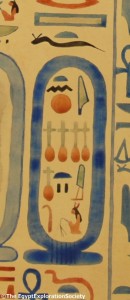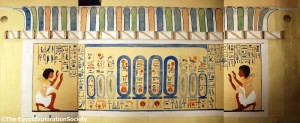The Cartouche of Nefertiti
Akhenaten and his Great Royal Wife Nefertiti are prominent characters in Mary Chubb’s imaginative response to the city they built, so I feel they need to appear more than once in the embroidery as well. The trick is to balance the story of the archaeology and the archaeologists with the story of the ancient inhabitants..
The gauze overlays I plan will give the sense of the Pharoah and his Great Royal Wife brooding over their city, but among other things I want to include their cartouches.
A few weeks ago, I attended an evening lecture about woven patterns discovered by Howard Carter in Tutankhamun’s tomb (more on that another time!) at the Egypt Exploration Society, and spoke briefly with the Director, Chris Naunton, who has been very helpful to my research in the past. I mentioned that I would like to do at least one set of cartouches in colour. There was a thoughtful pause, then he said “I think I have the very thing – send me an email to make sure I don’t forget, but it is just a matter of finding the file!”
I hadn’t even arrived home the next day when an email showed up in my inbox. The image showed a composite of watercolours by Hilda Pendlebury, depicting Hatiay’s Lintel. This was a carved and painted door-lintel discovered in the very season Mary was writing about, and what’s more, mentioned at some length in the book. It was both archaeologically and historically interesting (two of the cartouches were scratched out in antiquity), as well as providing a challenge to transport, being large, heavy, and because of the embellishment rather fragile.
My current thought is that I will work a version of the cartouche of Nefertiti, either in cottons or silks, either directly on the pale faience coloured linen or maybe on the fabric I used for the Faience Hippopotamus, which would help to balance him slightly. I’ve been reassured that I won’t give any Egyptologists apoplexy if I tweak the colours slightly….!



I can’t wait to see how this develops. How wonderful to have the image of Pendlebury’s lintel appear so quickly. Pays to know the right people. 🙂
This would look good on the hippo fabric, wouldn’t it?
That’s a lovely piece. It will look amazing once you stitch it.
What a wonderful image to work from, and an interesting background story to the piece. It’ll be great to see how this progresses. Have a lovely Christmas Rachael! xCathy
This is so fascinating, I do love the composite work. Looking forward to see how you approach this!
I really like those Egyptian patterns! Good luck working with it.
The whole lintel looks like a Fun Project (hint, hint) but the elements will be very useful if you have gaps at the assemblig stage as well.
These images are so wonderful. I love it that you are working with antiquity pieces and bringing them back to life.
Such a fascinating subject. Looking forward to see the progress.
Oh I love the ‘digging’ for information. You are on your own journey along with Mary Chubb. Isn’t it wonderful to walk along with someone from the past? I think the cartouches will look wonderful. It is like graffiti on the wall. “I have been here”.
You really have a good study of history to apply on you work.
Oh, I like this one, too. Two great projects for 2016 playing. =)
Wonderful – serendipity at work. This will be wonderful to watch your progress – I love Egyptian art.
beautiful imagery Rachel…these can’t fail to inform.